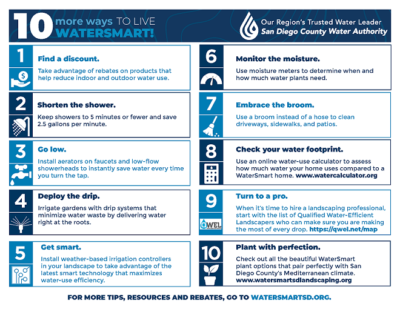Rebates are available for San Diego County residents seeking to reduce their water use and water bills, as drought persists across the Southwest U.S. The second year of drought, and a statewide call for water-use conservation, makes this an ideal time to be “WaterSmart.”
Outdoor water-efficiency rebates
Outdoor water use is 53% of the water used by residential properties. Most of that water is applied to keep grass green. There are a variety of rebates and classes that can help you upgrade your turf landscape to a beautiful sustainable, water-saving landscape. To learn more, visit WaterSmartSD.org. Available rebates include:
- Turf Removal – Rebates start at $3 per square foot for qualifying projects that replace grass with landscapes that incorporate water-saving plants, irrigation system upgrades and rainwater capture.
- Weather-Based Irrigation Controllers – Rebates start at $80 for controllers that automatically adjust the irrigation schedule to account for changing weather, soil conditions and plant types. For landscapes large than one acre, rebates start at $35 per station. Homeowners can save 8,800 gallons of water annually by replacing a standard clock timer with a WaterSense-labeled irrigation controller.
- Rain Barrels – Rebates start at $35 for up to two rain barrels, or $250-$350 for a cistern to collect rainwater for later use, while minimizing the amount of water flowing into storm drains, sewer systems and local waterways.
- Soil Moisture Sensor Systems – Rebates start at $80 on sensors for landscapes less than one acre and $35 per irrigation station for larger sites.
- Rotating Sprinkler Nozzles – Rebates start at $2 per nozzle for nozzles that apply water slowly and uniformly to prevent over-watering and encourage healthy plant growth. Participants must buy at least 30 nozzles from the list of qualified products.
- Flow Monitoring/Leak Detection Devices – Rebates start at $100 for qualifying models that monitor your home’s water use and can help detect leaks.
- Unincorporated Areas – Residents and businesses in unincorporated areas of San Diego County are eligible for increased water-use efficiency rebates under a new partnership between the County’s Watershed Protection Program and the San Diego County Water Authority. Water customers in unincorporated San Diego County can determine their eligibility at: SanDiegoCounty.gov/WatershedRebates.
Indoor water-efficiency rebates
Indoor water use makes up 47% of water used on residential properties. A homeowner can save four gallons of water during every shower by replacing showerheads with WaterSense-labeled models. Available indoor rebates include:
- Premium High-Efficiency Toilets – Rebates start at $40 for toilets that use 1.1. gallons per flush from the qualified list. Toilets make up 30% of a typical home’s indoor water use.
- High-Efficiency Clothes Washers – Rebates start at $85 for washers. Qualified products are listed at com and additional rebates may be available from San Diego Gas and Electric at sdge.com. High-efficiency washers have a 55% water savings and 25% energy savings.

Ten tips to live WaterSmart. Graphic: San Diego County Water Authority
Free landscape makeover classes and resources
The WaterSmart Landscape Makeover Program will help you create an outdoor space that loves San Diego as much as you do! The classes and videos offer the skills, knowledge, and confidence to turn turf areas into outdoor rooms that will thrive in San Diego County’s climate. The four-class series is taught by local landscape professionals who focus on creating actionable design, planting, and irrigation plans for each participant’s landscape.
Three-hour virtual workshops are also available and focus on various landscape topics with a “do-it-yourself” approach. The Landscape Makeover Videos on Demand series mirrors the content of the four-class series, taking homeowners step-by-step through the process of creating water-efficient landscapes. Twenty short, entertaining videos cover topics ranging from soil health and plant selection to rainwater harvesting.
Free WaterSmart checkup
Homeowners who would like advice on lowering their water use, adjusting their irrigation controller, or upgrading their irrigation system can schedule a free on-site WaterSmart checkup by going to WaterSmartCheckup.org. A WaterSmart Checkup is an opportunity to receive free, site-specific water-saving recommendations. Homeowners benefit from the perspective of certified irrigation professionals and decide if and when to implement the suggestions. There is no obligation. Savings can top 20%.
The Water Authority’s Qualified Water Efficient Landscaper Program trains professionals in water-efficient landscape principles and practices, including soils, plant selection, irrigation systems, and scheduling specific to the region. They’ll help you upgrade and maintain your landscape with a focus on the San Diego climate. To find a pro in your area go to qwel.net.
WaterSmart living may not only save money, but create vibrant yards, reduce energy use, protect natural resources, reduce landscape maintenance, and improve property values. It also creates a shared sense of purpose about how San Diegans use their limited water supplies — in a word, WaterSmart.




